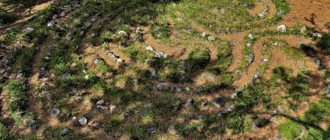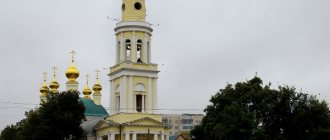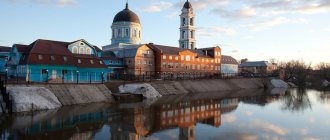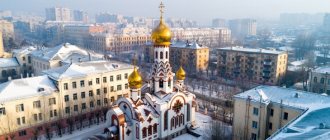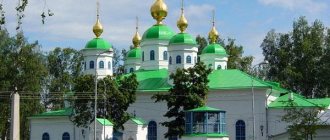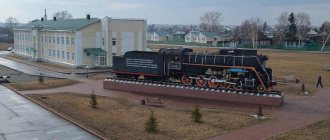Meet Cherepovets
The city is located 125 kilometers from Vologda, at the confluence of the Yagorba River and the Sheksna. Almost 320 thousand people live here. It is the largest city in the Vologda region, both in terms of population and area.
Cherepovets was first mentioned in documents in 1362 in connection with the founding of the Resurrection Monastery here. Gradually, the shrine was overgrown with villages and small settlements. Cherepovets received city status in 1777. At that time it was famous for its fisheries. In particular, local sterlet was highly valued, which was directly delivered to the royal table. At the beginning of the twentieth century, Cherepovets was nicknamed the “Russian Oxford” for its large number of educational institutions. The construction of the Volga-Baltic water corridor and the creation of the Rybinsk reservoir in the 30s of the last century gave a new impetus to the development of the city. Soon Cherepovets turned into a major port, and it began to be proudly called the “city of five seas.”
Modern Cherepovets is the most important industrial center and major transport hub of the country. Today there are 1,500 enterprises operating here. The city itself is one of the ten largest industrial centers in Russia. The main sectors of the city's economy are ferrous metallurgy, the chemical complex, metalworking and woodworking industries.
Cherepovets is also famous for its people. At different times, the Vereshchagin brothers, the poet Igor Severyanin, Valery Chkalov and other outstanding personalities lived and worked here.
Monuments of Cherepovets
Cherepovets is located on the territory of the Volgograd region, at the confluence of the Yagroba and Sheksna rivers. The city was founded in 1777 and is considered the most important transport and industrial center. It has a large population and an impressive area, which is not typical for most regional cities. However, Cherepovets is famous primarily for its rich and quite interesting history. It began back in 1362 with the construction of the Resurrection Monastery for men. Local people are extremely proud of their rich past, and this is reflected in the numerous monuments, war memorials and historical sites. There are sculptures dedicated to V.I. Lenin, V.V. Vereshchagin and G.K. Zhukov, as well as a bust of the famous Soviet poet N.M. Rubtsov. Decorating city streets is an extremely important matter, which is why it continues here to this day. Modern art objects and compositions appear, distinguished by their beauty and special historical significance. Walking around the city, you can admire the Cherepovets Globe or see the memorial dedicated to the liquidators of the Chernobyl disaster.
There is also a monument to Soviet metallurgists in the city, and it is called “Continuity of Generations”. The monument was erected in 2006 and dedicated to the 50th anniversary of the Cherepovets Metallurgical Plant. It is made of marble, and the local sculptor A. Shebunin worked on the project. The composition consists of a memorial stele, symbolizing a flame escaping from a steel-smelting furnace. To the right of the stele sits a stern worker and watches his young son. The composition symbolizes the continuity of generations and the importance of the Russian metallurgical industry.
Cherepovets also remembers the soldiers who died in battles with Nazi Germany. A memorial to military glory has been erected on the territory of the city military cemetery. It appeared here back in 1975 and dedicated to the 30th anniversary of the Great Victory. The composition consists of the figure of a Soviet soldier bowing before the Eternal Flame. Behind the soldier is a memorial plate with high relief and memorial text. The sculptor A.V. Shchepelkin and the capital’s architect V.E. Shalashov worked on the composition.
The monument to the nurse is also worthy of attention. The monument was founded in 2015 and is dedicated to the nurses who worked during the Second World War. The project was completed by the capital's architect A. Rozhnikov, on the initiative of grateful city residents. Visitors are presented with a composition made in an unusual three-dimensional style. Shown here is a nurse, dressed in a military uniform, holding the hand of a little girl. Behind them stood the wounded refugees, hoping for a quick rescue.
There are other iconic cultural attractions in the city. Arriving in Cherepovets, you can see the sculpture of Athanasius and Theodosius, stand at the military obelisk “Bayonets” or admire the memorial sign created in honor of the founding of the city.
Monument to Athanasius and Feodosius in Cherepovets
If you believe the legend, then Cherepovets was founded by two people - the wealthy Moscow merchant Theodosius and the student of Sergius of Radonezh Afanasy. It was they who founded the Resurrection Monastery in 1362.
The sculptural group depicting two monks is perhaps the most iconic monument of Cherepovets. It is located in the very center of the city, on Cathedral Hill. The monument was erected here in 1992. The height of the bronze figures is four meters. The Monk Theodosius points with his hand to the mountain where a vision once appeared to him.
Monument to I. A. Milyutin
The monument to the first mayor Ivan Andreevich Milyutin adorns the square in front of the new building of the city registry office. It was installed on the spot where the official was supposedly buried in 1907. Residents of Cherepovets began collecting money for the construction of the monument immediately after Milyutin’s death. But the opening of the sculpture took place only 90 years later. Its author is the sculptor Alexander Shebunin. On the pedestal of the monument you can see a sign with the following inscription: “To Ivan Andreevich Milyutin, the first head of Cherepovets, with repentance from fellow citizens.”
Monument “Continuity of Generations”
Of course, there is also a monument to metallurgists in Cherepovets. Officially it is called “Continuity of Generations”. The monument was erected in 2006 on Metallurgists Square in honor of the 50th anniversary of Severstal OJSC, the main city enterprise. 16 authors from different cities of the country took part in the competition for the best sculpture project. But the winner was local architect Alexander Shebunin.
According to the author’s plan, the monument should convey two things to the townspeople: the continuity of generations in metallurgy and a confident look into the future. Therefore, in the central part of the monument we see a metallurgist father and his little son, walking in a helmet into that same bright future. In the background is a vertical stele, symbolizing the process of metal smelting.
The monument was cast in bronze in parts in the city of St. Petersburg. Many Cherepovets were puzzled by the disproportionate size and gait of the child, however, this sculptural composition has long become one of the main city symbols.
Monument to Heroic Nurses
One of the most touching monuments in Cherepovets is the monument to nurses. During the Great Patriotic War, the city, located in the front-line zone, turned into one large hospital. During the hottest days of the war, up to 16 trains with wounded and evacuated people passed through Cherepovets every day.
To perpetuate the heroic and selfless work of medical personnel, it was decided to erect an appropriate monument in the city. In 2014, the sculptural composition decorated the square in front of the city station. After all, it was here that the wounded from the front arrived en masse. In the foreground are a nurse and a little girl with a doll in her hand, then a soldier wounded in the leg, followed by a group of refugees. The total weight of the sculpture group is 2.5 tons.
Orthodox shrines of Cherepovets
The city has small temples-chapels, as well as temples and cathedrals. One of the buildings worth seeing is dedicated to the founders of Cherepovets.
Chapel of the Icon of the Mother of God Life-Giving Spring
The history of this building is not very ancient, but eventful. At first the chapel was wooden, then a stone building was erected in its place. After the Civil War, the former chapel was adapted for household needs, and the source was blocked.
Only in 2000 did the restoration of the building begin. In 2014, the Divine Liturgy was held there, and the chapel became a temple dedicated to the icon of the Blessed Virgin Mary.
To get to the building, you need to get to Lenin Street and find house 1a.
Temple of Saints Athanasius and Theodosius of Cherepovets
This religious building was erected relatively recently, in 2012.
The cathedral was named in honor of the founders of the city of Cherepovets. Address: Makarinskaya Grove, building 1.
St. Nicholas Chapel
The building was built in 1904; 20 years later the chapel was closed. After the collapse of the USSR, this small church was opened again.
The shape of the building is cubic, the style of construction is false Russian. The chapel is located near the Cherepovets railway station.
Chapel of St. Philip of Irapa
This building was built in the 1870s at the expense of the abbots of the Filippo-Irap desert. The chapel was closed under Soviet rule.
In post-Soviet times, the building was restored, and the interior was updated. In 2000, the relics of St. Philip of Irapa were found.
Attraction address: Sovetsky Prospekt, 31.
Monument to the builders of Cherepovets
The monument dedicated to the architects and builders of the city is quite unusual. It is a massive bronze ball with a master plan for the development of Cherepovets engraved on it. The ball, popularly nicknamed the “globe,” is mounted on a granite pedestal and framed by twelve stone “petals.” On each of the slabs there are plaques with the names of those construction organizations that made a significant contribution to the development of Cherepovets.
The monument was erected in 2008 in a symbolic place - in the park in front of the Stroitel cultural center. The author of this project was the architect Alexander Kovnator.
Source
What to see in Cherepovets, Vologda region
The history of the emergence of Cherepovets is completely non-trivial. Even in the chronicles of the 14th century. You can find mention of the Resurrection Monastery, located on the site of the current polis. Later, a settlement was formed near the monastery, which became a district town after its abolition in 1777. For a long time, Cherepovets did not stand out among its many provincial counterparts. The period of progressive development of the policy began with the opening of the Volga-Baltic shipping canal. The advantageous location at the intersection of transport arteries has brought many dividends to the city. Logistics terminals appeared here, and later a metallurgical plant. It was this enterprise that was destined to become a city-forming one. Modern Cherepovets is considered by many to be the main city of the region. Although the status of the administrative center is assigned to Vologda , the most significant industrial enterprises of the federal entity are located here. In addition, the city ranks first in the region in terms of number of inhabitants and area. The sights of Cherepovets, with photos and descriptions of which you are about to familiarize yourself with, will certainly interest the inquisitive tourist.
Sights of Cherepovets: TOP-5
Every city has attractions that make it recognizable. This category includes architectural, monumental, and infrastructure calling cards of Cherepovets, which will be discussed below.
Monument to Athanasius and Theodosius
The founders of Cherepovets are considered to be the monk Afanasy and the merchant Theodosius. According to legend, the boat of a merchant, who set off on a trade voyage from Moscow , ran aground near the confluence of the Yagorba River with the Sheksna. Theodosius was struck by a mysterious halo over the hill. The merchant who climbed the hill was so delighted by the opening landscapes that he erected a small chapel on the top, where he left the icon of the Resurrection of Christ. This happened in 1362, and a little later the hand of the Lord brought here the monk Athanasius, the founder of the Resurrection Monastery. The monument to the city fathers was inaugurated in the summer of 1992. Since then, the sculptural composition of two bronze figures surrounded by arched pylons has been considered a symbol of Cherepovets.
Resurrection Cathedral
The history of the Resurrection Cathedral, another calling card of Cherepovets, is filled with various events. The church, consecrated in 1756, took a long time to build and survived several fires. After the Revolution, the temple was occupied by renovationists for some time, and then a repair shop was located within its walls. However, justice prevailed. The authorities returned the cathedral to the believers. After restoration at the end of the last century, the oldest stone building in the city is in good condition. The architecture of the temple is not typical for Northern Russian churches. The exterior of the building is dominated by elements of classicism. Under the shadow of the temple, revered shrines are kept - shrines with particles of the relics of the martyr Barbara, John the Warrior, John the Baptist, Alexander Svirsky.
Galisky Estate
Having visited this place, tourists will be able, at the same time, to admire the wonderful monument of wooden architecture and view the exhibitions of the historical and ethnographic museum. The building can be considered an example of provincial estate architecture of the early 19th century. The six-column portico of the second tier of the facade is especially impressive. In the interior of the mansion, the surroundings of a noble estate have been recreated. Tourists will see interiors resplendent with antique furniture, paintings, and impressive fabric decor. During the excursion to the stables, those interested will be offered a short horse ride.
Oktyabrsky Bridge
Since the last third of the last century, one of the symbols of Cherepovets has been the bridge that connected the Zasheksninsky and Industrial districts of the city by road. The infrastructure facility, put into operation in the fall of 1979, became the first such cable-stayed structure built in Russia. The steel cables holding the structure above the waters of the Sheksna converge on a single massive concrete pylon. The total length of the bridge is 781 m, and the length of the main span is more than 194 m. Sidewalks are installed along the road surface. The figured casting of the parapet fences copies the intricate lace of Vologda craftswomen. The bridge looks especially enchanting in the evenings on holidays, when the decorative illumination floodlights are turned on.
Monument “Continuity of Generations”
The rating of iconic sights of Cherepovets is completed by the monument to metallurgists. The sculptural composition, installed for the 50th anniversary opposite Komsomolsky Park, is filled with special meaning. The carved stone stele symbolizes fire and metal. Below it is a figure of a foundry worker, as if directing his little son towards the factory entrance. The worker does this for a reason. As you know, many family dynasties work in the workshops of the metallurgical giant.
Temples you must visit
Cherepovets is famous for several churches that have survived over the centuries. The city is visited by pilgrims, believers, and tourists. They are interested in the venerable monuments of the Orthodox Church. By visiting local shrines, people find peace of mind and feel God’s mercy upon them.
Church of the Nativity
At the origins of the temple, a wooden structure dedicated to St. Nicholas the Wonderworker is mentioned. The saint is known as the patron saint of travelers and sailors.
In the 16th century, instead of a wooden building, the Church of the Nativity of Christ was erected. By the end of the 1980s, the cathedral, like many other churches, was desolate.
The Cherepovets Museum provided historical and architectural materials, on the basis of which the church restoration project was carried out. It was practically rebuilt. Construction and renovation work took 6 years.
The renovated cathedral was consecrated in 1997. The single-domed snow-white building has become a radiant and memorable decoration of Cherepovets.
The architectural complex consists of an upper and lower temple. In the lower one, ceremonial baptismal ceremonies are held. There is an original marble baptistery there. The temple preserves valuable icons. Reliquaries contain particles of saints and great martyrs.
In 2005, a donated capsule containing a particle from the Life-Giving Cross of the Lord was brought from Jerusalem. They placed this gift in the Crucifixion.
Temple bells were made in Voronezh. Their ringing can be heard far beyond the city limits.
On Wednesdays, during the evening service, an akathist to St. Nicholas is performed. Every Saturday, before the icon of the Mother of God called “The Inexhaustible Chalice,” a prayer service with an akathist is served.
The Church of the Nativity is the first to greet guests who arrive in the city by river. The bell tower topped with a spire is visible from afar. Strict classical forms give the temple a resemblance to a ship. The red copper-clad domes are akin to symbols of warmth and shelter.
The temple is located on the street. Parkovaya, 1.
Resurrection Cathedral
In the 14th century, monks of the Trinity-Sergius Lavra founded the Resurrection Monastery. According to an established tradition, temples were built in monasteries. In 1752 - 1756, a stone Resurrection Cathedral was erected in the monastery. Cherepovets received the core, which became the beginning of the city.
The cathedral is a 4-pillar building, rectangular in plan. The building is crowned with 5 domes. They have the shape of 8-sided shapes. The bulbs are covered with gold. External decorativeness indicates the features of the Moscow architectural style.
The main entrance is decorated with a mosaic face of Christ. The altar (place for prayer) is the most ancient part of the cathedral. Among the temple treasures are reliquaries with the remains of John the Baptist, Alexander of Svir, Great Martyr Barbara, John the Warrior and other saints.
The Church of the Resurrection of Christ is located on Cathedral Hill. The building rises near the confluence of the Yagorba River and the Sheksna. This is the center of old Cherepovets.
The current address of the cathedral: Sovetsky Prospekt, 1.
Church of St. Nicholas the Wonderworker
In 1904, a chapel in the name of St. Nicholas was built on the station platform. Now a small altar has been installed inside the building, like in a temple. This allows for regular worship services.
St. Nicholas Chapel is distinguished by its distinctive Russian style. Intricate decor adorns the facades. A variety of profile bricks were used in the construction. The white and turquoise color gives it a special tenderness.
The chapel became a small temple decorating the entire station complex. The architecture of the chapel is extremely elegant.
In 2016, a particle of the relics of St. Nicholas was transferred to the chapel. This happened during Lent. Since that time, the shrine has been open for worship. Anyone can venerate the relics at a time convenient for them (08.00 – 20.00).
Before the relics, every Wednesday evening, an akathist to the Saint is read. A prayer service is ordered in the chapel for increased love and a safe journey. They also turn to the saint with other requests.
Theaters and museums of Cherepovets
The fact that the city is not in vain considered a major cultural center of North-West Russia can be judged by the number of local museums and theaters. Therefore, tourists have no problems with where to go in Cherepovets to have an interesting time.
Metallurgy Museum
Cherepovets owes its fame as the metallurgical capital of North-West Russia. It was after the construction of the industrial giant that the city began to develop rapidly. In 2015, a unique museum began operating at the enterprise, whose products are known far beyond the borders of the Russian Federation. Here you can get acquainted with the history of Russian and world metallurgy in retrospect. Particularly popular among visitors are virtual interactive tours of Severstal workshops using 3-D glasses, as well as demonstrations of various physical and chemical experiments.
Museum of History and Local Lore
Guests of the museum are invited to take a historical journey through the past of the Cherepovets land, ending in our time. Among the exhibits here you can see samples of weapons of soldiers of the Golden Horde, grenadier uniforms and guns of the 19th century, luxurious ball gowns of ladies who waltzed at balls 200 years ago. Some reconstructions recreate the ambiance of the apartments of city residents of the 30s and 50s of the last century. In addition to viewing the permanent exhibition, tourists will be offered a sightseeing tour of the city.
Art Museum
Visitors to the local gallery will be pleasantly surprised by the fact that, unlike most provincial art museums, its collection contains quite a lot of originals, not copies, of paintings by famous artists. In the exhibition halls, in particular, paintings by the luminaries of Russian painting K. Bryullov, B. Kustodiev, F. Rokotov, I. Repin are displayed. The institution has excellent collections of antique porcelain, colored glass and bronze. The highlight of the collection is considered to be ancient icons, in particular, the image of St. Nicholas, dating back to the 14th century.
House-Museum of V. Vereshchagin
One of the most famous natives of Cherepovets is rightfully considered the wonderful Russian battle painter V.V. Vereshchagin (not to be confused with the talented portrait painter V.P. Vereshchagin, who was born in Perm). Vasily Vasilyevich’s canvases cannot be confused with paintings by other painters. They were made with a deep knowledge of texture, because the artist traveled a lot and took part in hostilities more than once. Painting was not Vereshchagin’s only passion. He also published 12 books, which his contemporaries read with pleasure. Today, in the Vereshchagins’ house there is a museum where you can admire the works of the amazing master and learn many interesting details from his life. The museum building is a monument of wooden architecture.
The main attractions of Cherepovets
There are plenty of attractions in Cherepovets - which one is more interesting, where a tourist should go first - it’s up to you to decide. Photos of the city are the living history of Russia, because people lived here who left us a rich cultural and spiritual heritage.
Resurrection Cathedral
The date of construction is the 14th century, the place is where the Yagorba River flows into Sheksna. Until 1752, the church was wooden; later a stone structure appeared in its place. In 1852 the roof of the cathedral was replaced.
After the October Revolution, mass closures of churches began, and the Resurrection Monastery did not escape this fate. Of the entire complex, only the Resurrection Cathedral was able to be restored in the 1990s.
It is worth noting: work on the restoration of the temple continues to this day.
Cathedral address: Sovetsky Prospekt, building 1.
Church of the Nativity
The church was built at the end of the 15th century at the crossing of the Sheksna River. The wooden structure could only stand for two centuries, then collapsed. A stone structure was erected on the site of the collapsed structure, and in 1789 the church was consecrated.
In 1931, the church was abolished, the building was used for economic needs. In 1989, fire destroyed the structure. After the collapse of the USSR, the revival of the temple began. Construction was successfully completed in 1997.
Please note: the external appearance of the building is the same as in the pre-revolutionary years.
Temple address: Parkovaya street, building 1.
Vereshchagin House-Museum
As we mentioned above, Cherepovets is the birthplace of battle painter V.V. Vereshchagin. The artist drew well since childhood; perhaps his childhood pencil drawings also depict pictures of his native Cherepovets. Vasily Vasilyevich studied at a military school, participated in a number of battles and created paintings of different genres. Vereshchagin’s most famous painting is “The Doors of Tamerlane,” which sends us back to a distant era when Central Asia was ruled by the powerful ruler Timur-Tamerlane.
Vereshchagin took part in the Russian-Turkish War of 1877-1878, as well as in the Russian-Japanese War. April 13, 1904 was a truly dark day: the warship Petropavlovsk hit a mine and sank, and among the dead was V.V. Vereshchagin.
Since 1984, the house where the famous artist was born and other buildings of the Vereshchagin estate have become a museum complex. The address of the house-museum is Sotsialisticheskaya Street, building 22.
House-Museum of Milyutin
Ivan Andreevich Milyutin ruled the city of Cherepovets for a little less than half a century (from 1861 to 1907). The mayor is mentioned in one of the so-called “military aphorisms” of Kozma Prutkov (“it’s good to fish where the water flow is cloudy - long live Cherkessky and Milyutin!”).
House-Museum of I.A. Milyutin was opened in 2006. Address: Revolution Square, building 1.
Literary Museum of Igor Severyanin
Igor Severyanin is one of the most mysterious poets in Russia. The author of light, “airy” poetry, a classic romantic, little known to Soviet readers. The reason is an emigrant. An atmosphere of scandals and legends has developed around Igor Vasilyevich Lotarev (Severyanin - literary pseudonym). Even today, some of the riddles that this mysterious eccentric asked us remain unanswered.
This is interesting: for a long time there was no museum dedicated to Igor Severyanin. Only in the 1990s did the Lotarev estate, where there was a collective farm sanatorium under Soviet rule, become a literary museum.
The outwardly nondescript house has a unique furnishings - a mixture of pre-revolutionary and Soviet styles.
The address of the museum is the village of Vladimirovka, Severyanina Street, building 1.
Museum of the Metallurgical Industry
There is a museum dedicated to metallurgy in Cherepovets. Nostalgia awakens for Soviet times, when we were “...ahead of the rest.”
Visitors will get acquainted with the history of this industry and learn interesting facts about the Cherepovets Metallurgical Plant. Address: Mira street, house 42.
Museum of Nature
The history of this museum begins in the 1920s.
The building houses exhibitions dedicated to both the nature of the city and its surroundings, and long-extinct plants and animals. Address: Lunacharsky Avenue, building 32.
Monument to Saints Athanasius and Theodosius
In October 1992, when the anniversary of the birth of V.V. was celebrated. Vereshchagin, a monument to the founders of the city, Athanasius and Feodosius, appeared in Cherepovets.
Historical fact: Theodosius was once a merchant, but after the death of his family during a plague epidemic he became a monk. Monk Athanasius was a hermit, he was known by the nickname “Iron Staff”.
The monument was erected near the Resurrection Cathedral.
Oktyabrsky Bridge
The construction of the bridge across the Sheksna River began on the day when the centenary of the birth of V.I. Lenin. Nine years later, vehicles began to travel across the Oktyabrsky Bridge.
Please note: this was the first cable-stayed bridge in Russia (then the RSFSR). Moreover, the structure was very similar to the Cologne bridge over the Rhine.
Galisky Estate
Architectural landmark of the city. Unlike other Cherepovets estates, where most of the buildings were not preserved, the Galsky estate successfully survived the revolution and the Civil War.
All buildings of the landowner's estate have survived to this day.
Address: Maturinskaya street, building 28.
Art Museum
Opened under Soviet rule.
Among the exhibits are paintings, sculptures, and a collection of icons created from the 14th to the 19th centuries. The exhibition hall displays the works of contemporary masters. Address – Sovetsky Prospekt, building 30a.
Monument to metallurgists
Cherepovets is famous for its metallurgical plant.
In honor of the workers, a monument was erected on the city square in 2005, symbolizing the continuity of generations of metallurgists. To get to the attraction, you need to get to Metallurgists Square.
Chamber theater
The history of this building begins in the 1860s, when a troupe of amateur actors appeared. In 1938, a theater with a professional troupe opened, but it only worked until 1948.
It is July 1, 1993 that is considered to be the birthday of the Chamber Theater. After the revival, the theater received its own building. Address – Sovetsky Prospekt, building 35B.
House of Volkovs
This building was built at the beginning of the 19th century. The house was two-story, the first floor was dedicated to a wine store, and the second floor was residential.
The exact layout of the house is unknown - the papers with the plans were lost under Soviet rule.
Address: Sovetsky Prospekt, building 21.
Komsomolsky Park
The most famous vacation spot for locals. It received its name in honor of the Lenin Komsomol, whose members actively took part in the formation and development of the park.
This is interesting: previously, on the site of the park there was an old cemetery, where quite famous personalities were buried, for example, the former head of Cherepovets I.A. Milyutin.
Cherepovets churches and cathedrals
Temples occupy an honorable place in the list of attractions of Cherepovets. The city's cathedrals and churches will interest not only connoisseurs of religious architecture, but also ordinary tourists - connoisseurs of everything elegant and beautiful.
Church of the Nativity
The current Church of the Nativity of Christ, consecrated in 1997, was erected on the site of a church that had existed since the end of the 19th century, demolished by the Bolsheviks. The white-stone building with an antique portico and blackened roof is the first local attraction seen by travelers arriving in Cherepovets by river transport. Tourists' eyes are immediately attracted by the three-tiered bell tower, topped with an unusually massive high spire. The highlight of the interior is the carved iconostasis, created by the hands of excellent craftsmen from the Trinity-Sergius Lavra. Pilgrims are attracted to the church by the main temple shrine - the image of the Mother of God of Kazan, painted in the 19th century.
Cathedral of Theodosius and Afanasy Cherepovetsky
The delightful cathedral, consecrated in 2012 in the name of the Cherepovets saints Athanasius and Theodosius, can serve as convincing proof that even an architectural remodel can become a historical landmark. The authors of the building project coped with the difficult task perfectly. They managed to create an architectural masterpiece that embodied the features of ancient Russian religious architecture and classicism. The white-stone quadrangle with five light drums topped with gilded domes looks amazing. It is similar, at the same time, to the ancient churches of Vladimir , Suzdal and the churches of St. Petersburg . The main cross of the cathedral rises 35 m above the ground. The belfry has 12 bells cast by Ural craftsmen. The bell tower itself is covered by a 14-ton tent.
Chapel "Life-Giving Spring"
In the 18th century On the banks of the Yagorba a spring was found, the waters of which, according to legend, had healing properties. Soon a carved arch was built over the key, and a small chapel near it. The townspeople revered the shrine and annually held Friday religious processions to it on Bright Week. Everything changed with the coming to power of militant atheists. The Bolsheviks first closed the religious building and then used it for economic needs. The building gradually fell into disrepair and collapsed. A neglected wasteland has formed on the site of the shrine. Only at the turn of the century, through the efforts of an initiative group, the revival of the cult object began. By 2014, work on the construction of a new chapel and improvement of the surrounding area was completed. Today, religious processions are again held to a small temple dedicated to the Holy Mother of God.
List of Orthodox churches in the city of Cherepovets
The expanses of the Vologda region are dotted with many Orthodox churches. Several striking cathedrals are located in Cherepovets.
The list of Cherepovets churches includes the Resurrection and Annunciation Cathedrals. Many churches are also famous:
- Trinity;
- John the Evangelist;
- Pokrovskaya (at the Korzhakovsky cemetery);
- Presentation of the Lord;
- Nicholas the Wonderworker;
- Alexander Nevsky;
- Prison;
- Nativity of Christ;
- Joachim and Anna;
- Athanasius and Theodosius.
Where to go with children in Cherepovets
A young traveler can have a great time in Cherepovets for a small part of his vacation. There is something here to fill the leisure time of a child of any age.
Museum of Nature
A tour of the exhibition halls of the institution, occupying an area of about 500 m², will bring pleasure to both adult tourists and their beloved children. Unique exhibits are displayed here, telling about the nature and richness of the subsoil of the Cherepovets land. Natural landscapes are presented with colorful reconstructions, clearly demonstrating the diversity of flora and fauna of the region. The pearls of the museum's collection, which contains about 30 thousand exhibits, are considered to be extensive collections of minerals, fossilized remains of ancient animals and plants.
Children's Museum
Every adult sometimes wants to plunge into the carefree world of childhood. Doing this is doubly pleasant if your favorite child is nearby. This unique opportunity is offered to everyone by an amazing institution operating in Cherepovets. The basis of the exhibition is made up of collections of soft, wooden, and ceramic toys, and the colorful collection of designer dolls delights the children. In addition, visitors will be able to admire magnificent watercolors and canvases by the remarkable children's artist E. Boehm, who lived and worked in the late 19th and early 20th centuries.
Children's musical theater
If you take a child aged 3 to 12 on a trip, be sure to take him to this theater. Here young visitors are invited to immerse themselves in the wonderful world of music and fairy tales. This is something special! The presentation consists of several parts. First, children will be introduced to folk and classical musical instruments, then they will be shown an exciting performance accompanied by beautiful melodies and a small shadow theater performance. The show will conclude with “Pochitayka,” during which the lines of popular literary works for children, spoken by actors accompanied by accompaniment, will sound in a completely new way.
Don't miss the sights of other cities of the Vologda region - Totma, Veliky Ustyug and Vytegra
Architectural, historical monuments, museums, and interesting places of Cherepovets, which are described in the article, make the city, located on the banks of the Sheksna and Yagorba, very attractive for tourists. It's worth visiting here with the whole family.
Source
Interesting sights of Cherepovets - photos and descriptions
On our website you will find beautiful photos of the sights of Cherepovets and their descriptions.
Art gallery E.M. Lunina
The gallery was opened in 2001, with works displayed for viewing, but not for sale. Among the works are examples of brushes by graphic artists and painters (both famous and little-known artists), as well as sculptures. Address: Yubileinaya street, building 36.
Museum of History and Local Lore
The building was built in 1928. The museum constantly has an exhibition dedicated to the history of Cherepovets - a city as young as it is ancient.
Visitors will learn about how the soldiers of the Golden Horde dressed, what the first blast furnace was like, what living rooms looked like in the 1930s and 1950s, and so on. Address – Sovetsky Prospekt, building 30A.
Museum of Archeology
The museum was built in the 1870s.
Today there are more than 100 thousand exhibits here. Their age varies widely: from the times when mammoths still walked the earth to the 14th century. Address: Krasnaya street, building 1v.
Monument to Nikolai Rubtsov
Nikolai Mikhailovich Rubtsov is a famous Soviet lyric poet. The poet's fate was tragic: in mid-January 1971, Rubtsov died at the hands of his beloved, poetess L. Derbina (the most interesting thing is that the poet foresaw his death by writing the poem “I will die in the Epiphany frosts”).
In 1998, a monument-bust of Rubtsov was erected in Cherepovets.
Take note: in 1999, a tradition appeared on the poet’s birthday, January 3, to read his poems and discuss interesting facts related to the work of N.M. Rubtsova.

